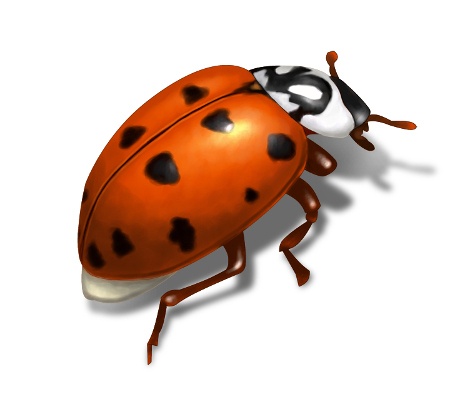
How to Get Rid of Ladybugs
If you an active ladybug infestation, follow these guidelines to control and get rid of ladybugs.

Asian Lady Beetle
The domestic Ladybug and the Asian Lady Beetle are both common in the USA. The picture above is the domestic ladybug beetle. The Asian lady beetle can be multi-colored and has a "w" or "m" ( depends on how you look at it) just behind the head. The Asian lady beetle is more likely to invade your home to overwinter.
Pest control methods of treatments would be the same for both types
How to identify and Inspect ladybugs


Ladybugs Identification
Ladybugs and Asian lady beetles are beneficial insects to gardeners because they are predators of garden pests like aphids and spider mites. In other words, we want lady beetles in our gardens, but a problem can happen when adult beetles try to enter our homes in the fall to shelter there until spring.
Most lady beetles head for the hills in the fall to shelter in natural cavities. A newly imported species, the multicolored Asian lady beetle, likes to spend winters at lower elevations, and our houses happen to be very handy. If they gain entry, they can be a pest all winter. They do no direct harm, but some believe they contribute to indoor allergies, and they can be very messy.
It is vital to prevent them from overwintering in your homes by spraying the exterior walls during the Fall months.
- The ladybug, commonly called the Asian lady beetle, is a pest and a beneficial insect.
- They are only a pest by their presence.
- Ladybugs do not feed on or damage anything in the home.
- Ladybugs do not carry diseases or sting, nor can they breed indoors.
- However, when large numbers of them take up residence in a home, they will crawl all over the walls, windows, light fixtures, and any other surfaces.
- Adult Asian lady beetles are oval, convex, about 1/4-inch long, and pale yellow-orange to dark orange-red. Although general body shape is usually similar, there are differences in size and coloration between ladybug species. However, in the United States, they are generally red or orange with black markings.
- If the Asian beetle is crushed, it leaves behind a yellow-like fluid that may stain clothing or surfaces. It has a foul odor.
Where They Overwinter
Lady Bugs, Asian Lady Beetles, cluster flies, and boxelder bugs are "overwintering" insects. Ladybugs are beneficial insects but can become a nuisance as they attempt to enter our homes during the fall months for shelter until springtime. They like to congregate on the sunnier southwest sides of buildings. The contrast of dark against a lighter color, such as dark shutters against a light‐colored wall, also attracts these beetles.
Asian Lady Beetles and other overwintering insect pests (cluster flies, boxelder bugs, and stink bugs) will hide in warm areas during the fall months. They can hide in many locations.
Areas To Inspect
- basements
- wall voids
- behind baseboards
- suspended ceilings
- attics
- closets
- garages
- crawlspaces
- cupboards
- in cabinets
- storage areas
- around light sources
- cracks and crevices
- underneath appliances
- The fabric of curtains or bedding that are not in use.
Prevention With Insecticides
PREVENTION is the best of all control methods.
Use a fast-acting synthetic pyrethroid such as Avesta CS or Cyper WSP to help prevent Asian lady beetles, cluster flies, box elder bugs, and similar over-wintering pests from entering your home in the fall.
Avesta CS will dry without a visible residue on sprayed surfaces. Cyper WSP will leave a visible powdery residue against surfaces.
Fall and Spring Spraying
For best results, spray in the fall and spring on the house's south and southwest exposure. Spray the exterior walls from the ground up as high as you can go.
Spray the south and southwest exposures of the house from the ground up. Spray as high as you can go with a long-lasting residual insecticide like Avesta CS or Cyper WSP. Also, spray these residual insecticides around exterior windows, attic vents, eaves, attic vents, soffits, siding ( including under the lips), under fascia lips, doors, and any other possible points of entry, concentrating on the south and the southwest sides.
Mechanical Measures of Prevention
To help prevent Lady Bugs and Asian Lady Beetles from entering your home, caulk, screen, and seal openings on the outside perimeter of your home.
Pay particular attention to the house's south and west exposures as many ladybugs gather there to stay warm.
Remember, they can't get in if you seal them.
Particularly important to check are:
- Doors
- Window
- Water pipes
- Dryer Vents
- Gaps in siding
- Foundation vents
- Soffit vents
- Gable vents
- Ridge Vents

When They Become Visible and Active
When temperatures warm on a late winter day or spring, these beetles can become active. This first occurs on the south and southwest side of the building. Trying to escape to the outside, you can spot them around lighting, door frames, windows, and windowsills.
Residual Insecticides
Avesta CS with Lambda-cyhalothrin 9.7% is a long residual insecticide and does not break down easily outside on wall surfaces. It is odorless and does not leave a stain. Avesta CS combines the extended control of a micro encapsulated formulation with a powerful knockdown to provide long-lasting control. This product is a controlled release insecticide with little to no odor. Avesta CS will dry without a visible residue on sprayed surfaces.
Cyper WSP is a water-soluble insecticide sold in packs. Each envelope contains 4 packets. Use 1 packet per gallon of water for ladybug control. It is an odorless product just like Avesta CS but will leave a visible residue seen against dark surfaces.
Dusts
D-Fense dust (1 lb) is an all-around insecticide dust which provides an effective knockdown and residual control for up to eight months. D-Fense dust can be used to treat wall voids if there is no insulation to impede the spreading of the dust. It can also be placed around switch plate covers and electrical outlets as well as plumbing openings.
Aerosols
Stryker 54 Aerosol with 0.50% pyrethrin provides a contact kill and a quick knockdown. It would be useful to spray the ladybugs directly on contact to get a quick knockdown. PT 565 Aerosol has a crack and crevice applicator, which allows you to treat around windows, molding, and light fixtures. It would be useful to spray the ladybugs directly on contact to get a quick knockdown. The dust and aerosols should be applied to indoor cracks.
Aerosols
Stryker 54 Aerosol with 0.50% pyrethrin provides a contact kill and a quick knockdown. It would be useful to spray the ladybugs directly on contact to get a quick knockdown. PT 565 Aerosol has a crack and crevice applicator, which allows you to treat around windows, molding, and light fixtures. It would be useful to spray the ladybugs directly on contact to get a quick knockdown. The dust and aerosols should be applied to indoor cracks.
Ladybug Control Combo Kits
Combine residual insecticides with insecticide dust and duster for greater savings.
- Lady Bug Kit (large) contains 8 oz of Avesta CS, 1 lb of D-Fense Dust with Bellow Duster, and 1 Stryker 54 Aerosol.
- Lady Bug Kit (small) contains 2 envelopes of Cyper WSP and Stryker 54 Aerosol.
Window Fly Traps
Place these Revenge window fly catcher strips on windows to catch lady bugs and flying insects. Each box has 4 traps. Treat each window where the ladybugs are present.
Recommended Ladybug Control Measures
Recommended Products: Residual Insecticides, Aerosols, Dusts
Mechanical means of exclusion
- Sealing ladybugs or Asian lady beetles out by caulking cracks and around utility service openings, fixing broken window screens and door jams, plugging cracks in the foundation or roof as well as similar exclusion-type activities will help prevent the Asian beetles from entering in the first place.
- Shady areas are less likely to attract ladybugs.
Ladybug and Asian Lady Beetle Habits
Since ladybugs are tree-dwelling insects, homes, and buildings in forested areas are especially prone to infestation. Suburban and landscaped industrial settings adjacent to wooded areas also have sizeable Asian beetle aggregations.
Asian lady beetles or Ladybugs congregate in large numbers during the late fall rather than disperse to overwinter individually under bark or leaf litter, as do most lady beetles. Asian lady beetles or ladybugs prefer to cluster on the sides of homes and other buildings. They eventually work their way into the building through small cracks or crevices or natural breaks in the window panes, door jams, or foundations as the temperatures decrease. They are seeking a suitable place to spend the winter (overwinter).
Once inside the building, ladybugs hibernate until the first warm days of late winter or early spring, when they seem to come to life again and begin crawling.
Asian beetles tend to be attracted to lighter colored buildings, especially those illuminated by the sun (typically the south or southwest side of the structure). Darker colors and facilities in the shade are less likely to have problems.
After spending the winter months tucked away in a wall void or other secluded place, they have forgotten how they got in. When they become active in the late winter, ladybugs often find themselves inside the home rather than outside. At this time, ladybugs are merely looking for a way to escape to the out-of-doors. This reawakening may take place over several weeks, depending on temperatures and the size of the population.
Key Takeaway
Ladybugs enter the home in the fall seeking a warm place to overwinter.
Exterior perimeter treatments in the late summer and fall can minimize the number of ladybugs that get in.
Written by our resident pest control expert Ken Martin.




